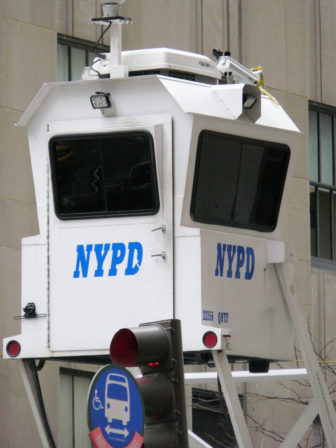
Arwen
The oppressive presence of police is a constant in my life. From the time I leave my house in the morning for school, to the time I come back home, the New York Police Department (NYPD) keep me, my friends and all low-income Black and Latino youth in their crosshairs. On any given morning, there are a dozen School Safety Agents stationed at the metal detectors at the entrance of my school. The line to get through the metal detectors goes out the building and down the block. If you have a glass bottle, nail file, or pencil sharpener, it could get you sent to the back of the line, or get you wanded down in front of everyone.
When we leave school there are police vans stationed out front, and it’s not unusual for officers to yell and harass us to leave the area. It’s a dehumanizing experience that is only acceptable in New York because we are poor Black and Brown students. It’s disheartening that we don’t see any change coming. In New York City alone, the Department of Education (DOE) spends $360 million annually on “school safety,” which really means school policing. There are over 5,500 School Safety Agents in our schools. New York City has the highest ratio of school police officers to guidance counselors in the country, with more than twice the number of police officers than guidance counselors in schools. And, statewide, we continue to invest in mass incarceration and policing while young Black and Latino youth and our families go without the resources, opportunities, and support systems we need to thrive.
This is the result of poor policy decisions over the past thirty years. As a new report, “The $3.4 Trillion Dollar Mistake,” shows, New York State spending (and spending nationally) on criminalization and incarceration of our communities has mushroomed over the past 30 years, while other critical social services and education and infrastructure investments have gone underfunded. The total New York increase: $232 billion.
When I think about New York spending $232 billion dollars on prisons, police, and the justice system in the last 30 years, the first thing I think about is my mom. My mother has raised me and my two siblings on her own, all while trying to survive from paycheck to paycheck. Spending money on things like our birthdays and holidays was considered a luxury and forced her to weigh presents against food and shelter. Public spending, like household spending, reflects our leaders’ choices—when I think about all the resources and funding used to criminalize people like me are the product policy decisions that can, and must, change.
It costs $208,500 to incarcerate a young person for one year in New York. It costs SUNY and CUNY colleges well under $30,000 to cover a year of college. Yet New York State continues to criminalize youth like me, and New York City is considering putting millions more into expanding Rikers Island. Investing so much money in prisons and not into our communities has impacted me severely. I have witnessed people I care about and love go to jail, including a close friend who was arrested before we made it to high school. I know his life would have been different if our communities had the resources we need—resources for things like living wage jobs for our parents, adequately resourced public schools, affordable and quality housing, and full youth employment.
Seeing billions spent every year in New York to funnel young people of color like me into prisons, rather than investing in our neighborhoods, it makes me wonder what the future holds for me. My mother always told me that a parent should never have to bury their child, but she lives with the fear that she may have to bury one of us, the same way my grandmother thought she would have to bury her or my uncles and the same way I feel that I would have to bury my children.
The $232 billion that New York has spent in the last 30 years has meant: more beds in jail for black and brown bodies; an explosion of broken windows and abusive policing; and schools that abound with police officers, while lacking the arts and physical education, guidance counselors, college counselors, and restorative justice programs we need.
New York must learn from its costly mistake and radically transform our funding priorities. Reinvesting in our communities means we would have an opportunity to grow up in healthy, sustainable environments full of love. For young people like me, investing in our communities literally means the difference between life and death.
Zion Harley is a Youth Power Project member of Make the Road New York. On Twitter: @MakeTheRoadNY








